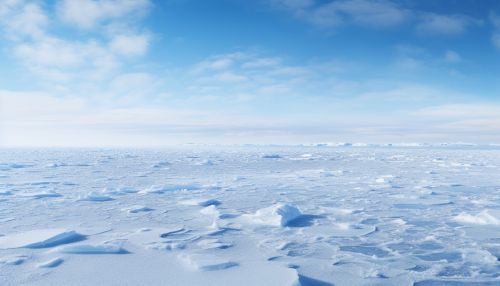Nilas (ice)
Introduction
Nilas is a type of sea ice that forms on the surface of the ocean. It is characterized by its thin, elastic, and transparent nature, which distinguishes it from other forms of sea ice. Nilas ice is typically less than 10 cm thick and can cover vast areas of the ocean surface, particularly in the Arctic and Antarctic regions.


Formation
Nilas ice forms when the surface of the sea begins to freeze. This process, known as sea ice formation, occurs when the air temperature drops below the freezing point of seawater, which is typically around -1.8 degrees Celsius. The formation of nilas ice is a complex process that involves several stages. Initially, tiny ice crystals known as frazil ice form in the water. These crystals then coalesce to form a soupy layer of slush known as grease ice. As the freezing process continues, the grease ice solidifies into a thin, elastic sheet of ice, which is nilas.
Types of Nilas
There are two main types of nilas ice: dark nilas and light nilas.
Dark Nilas
Dark nilas is a thin layer of ice that is less than 5 cm thick. It is so thin that it bends easily under the action of waves and wind, and it often appears to be almost black in color due to the underlying seawater. Dark nilas is typically the first stage of nilas ice formation.
Light Nilas
Light nilas is slightly thicker than dark nilas, typically between 5 and 10 cm thick. It is less flexible than dark nilas and has a lighter, grey-white color. Light nilas often forms on top of dark nilas as the freezing process continues.
Physical Properties
Nilas ice has several unique physical properties that distinguish it from other types of sea ice. One of the most notable properties of nilas ice is its elasticity. Due to its thinness, nilas ice can bend and flex under the action of waves and wind without breaking. This elasticity is a key factor in the ice's ability to cover large areas of the ocean surface.
Another important property of nilas ice is its transparency. Because it is so thin, light can penetrate through the ice, making it appear almost transparent. This transparency allows scientists to study the underlying seawater and the organisms that live there.
Ecological Significance
Nilas ice plays a crucial role in the marine ecosystem. It provides a habitat for various marine organisms, including phytoplankton, zooplankton, and ice algae. These organisms form the base of the marine food chain and are a vital source of food for larger animals such as fish, birds, and marine mammals.
In addition, nilas ice acts as a barrier between the ocean and the atmosphere, reducing the exchange of heat, gases, and moisture. This has significant implications for the global climate system, as it affects the ocean's ability to absorb carbon dioxide from the atmosphere.
Impact of Climate Change
The formation and extent of nilas ice are highly sensitive to changes in air and sea temperatures. With the ongoing climate change, the Arctic and Antarctic regions are experiencing warmer temperatures and reduced sea ice cover. This has led to a decrease in the formation of nilas ice, which could have profound impacts on the marine ecosystem and the global climate system.
